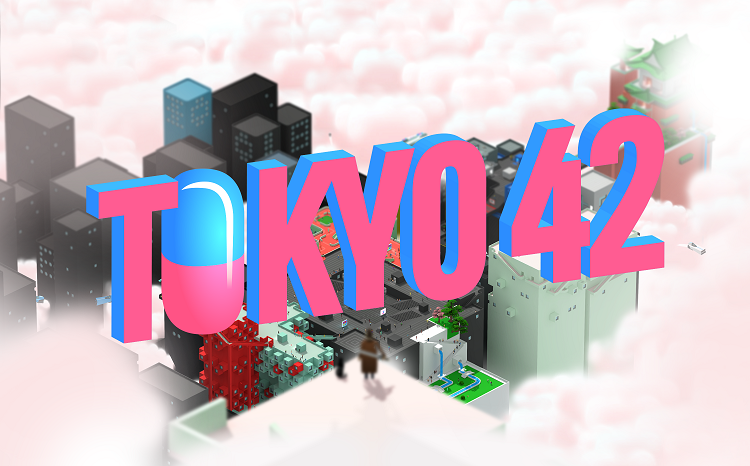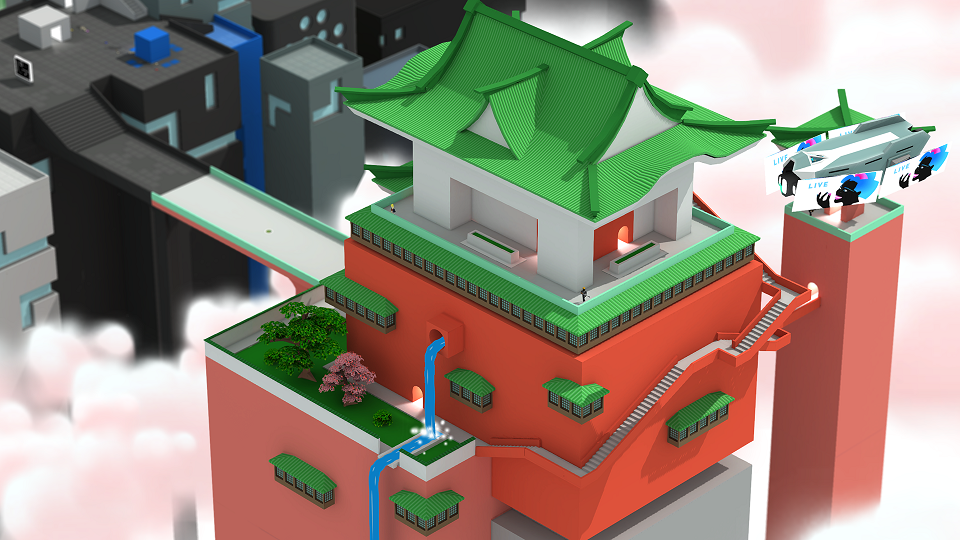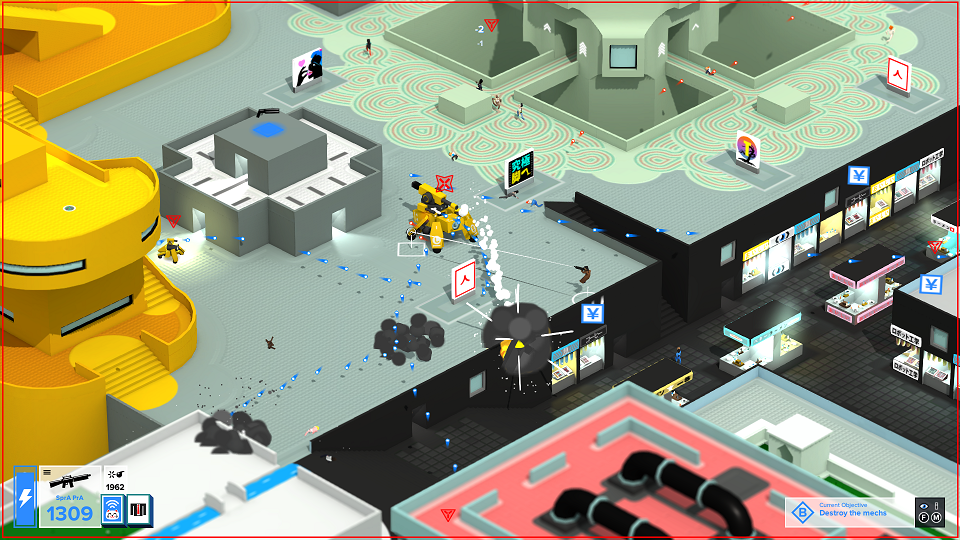Imagine a near-future world where the very first murder of the year is a newsworthy event, because people now have medicine and nanomachines to revive them if they die.
Imagine that you are an ordinary person living in this world that is framed for the murder, and you learn about it right as the police are coming for you. Imagine then that in order to clear your name and survive, you hide out and work as an assassin, which is now a legal and lucrative business; after all, your targets won’t truly die.
Welcome to the beginning of Tokyo 42. True to its name, the game is set in a cyberpunk view of Tokyo in the year 2042, loaded down with trappings borrowed from Blade Runner and Shadowrun, alongside other classics.
This version of Tokyo is fully realized in a good-sized open world map, tackled from an isometric perspective that allows you to view the strange and colorful splendor that the future city has embraced. Full of missions to complete, collectibles to find, and secrets to uncover, there’s quite a bit on offer at first glance. But how does Tokyo 42 hold up under scrutiny? Let’s dive in.
Get Rich or Die Trying
Tokyo 42 cites itself as a love letter to the original Syndicate and the top-down Grand Theft Auto games, and this is immediately apparent upon loading in. After the initial chase and escape in the intro sequence, you’ll be presented with the open world map and allowed free reign within it. With the objective of clearing your name, you immediately thrust yourself into the heart of the seedy criminal underbelly of Tokyo with the goal of building your reputation.
To do so, you’ll be largely roaming the map between mission locations and then completing the missions themselves. There’s a handful of characters as colorful as the city itself that will guide you and set you up with contracts, as well as automated terminals where you can pick up side missions. It’s largely a matter of picking your mission and then proceeding with it.
Missions themselves all take place within this large open world, usually cordoning off an area and filling it with hostile guards and goons. Your objectives are often diverse in terms of means and approach, but the end result is usually simple: kill the target.
You’re given an inventory wheel that quickly fills up with tools and weapons to select from, ranging from the relatively weak but fast-firing and infinite-ammo pistol, to assault or sniper rifles, to grenades and high explosive weapons. You also have the melee option of using a katana or other bludgeoning weapon. This gear will either be picked up as mission rewards or purchased from shops with your hard-earned cash, though replenishing ammo is often up to you. Should you run out of fancy powerful stuff, however, you’ll still have basic options to resort back to.
Tokyo 42 styles itself as a stealth game, and this usually an option (frequently the preferred option) presented to you. For example, an early mission has you climb to the top of a temple and assassinate the target with a blade. You thus have the option of going in all guns blazing and fighting to the top before executing the guy, or else sneaking around at a precise pace, taking out guards one by one with your katana until you can finish off the target and escape.
Gunfights in the game are usually quite frantic affairs, with bullets flying everywhere from all directions. Not only are they frantic, but they’re quite lethal, as a single hit will kill most targets in the game — the player included. Taking cover is advised, and your frailty means that stealth and picking your fights carefully is strongly encouraged. One single stray bullet can end an otherwise successful run and force you to start the mission over. There’s little other penalty besides this, but it can be a nuisance all the same.
The game is largely balanced between tackling these missions (whether simple shootouts or elaborate infiltrations) and giving you the freedom to roam around the world map and choose your next contract. While there aren’t too many main story missions, there are a whole slew of side missions for you to take on, as well as optional challenges within them to further spice up the game.
Cat and Mouse (But Mostly Cat)
Tokyo 42’s multiplayer mode is worth discussing. I unfortunately didn’t have a chance to test this myself, but many of its elements are presented quite clearly even in single player mode.
Often times in the campaign, completing a mission or shooting up a gang will cause a “Nemesis” to be deployed. You’ll be warned about this — it means that another assassin is attempting to hunt you down, and you’d best keep an eye out for them. Often, there will be no enemy warning or marker to identify them; you just have to keep an eye out and be ready for when that one NPC starts advancing on you with a katana.
The multiplayer plays a lot like this feature of the game. Players are deposited in an area full of NPCs and have to mingle while trying to identify one another and kill the enemy first. It plays a lot like the Assassin’s Creed multiplayer modes, and the concept is quite interesting.
One of the key means you have of identifying a Nemesis, be it NPC or player, is the tracking cat item. Deploying your cat will have it sniffing out your target, but of course instantly reveals you as an assassin to anyone watching — so it can be a double edged sword. The cat itself is customizable with collectible skins found in game, too. As such, Tokyo 42 truly can become a literal game of cat and mouse.
While I’m quite curious to see how how the multiplayer shakes out, I imagine that for a niche title such as this, it might be hard to build up more than a very small community of players. The game simply doesn’t have the play-by-play strategic applications of Frozen Synapse, a game released by Mode 7 (the publisher of Tokyo 42).
The Future is Stylish
The obvious thing to note from the screenshots I’ve included — and the detail that originally drew me into the game — is that Tokyo 42 is gorgeous, bringing to mind the recent title Monument Valley.
Individual character models are small and low detail — but with the camera zoomed all the way back, the city of Tokyo is the real star. You get to see a wide view of a stylish city that feels incredibly cyberpunk; a little too clean, a little too spotless, with strange advertising and eye-catching monuments or structures everywhere.
Exploring the city for a while is as much a cornerstone of gameplay as the missions are. There’s a lot of secrets to find — whether they’re little easter eggs that you can check off by observing them through your binoculars, or collectibles that include different weapon skins or cash drops.
In addition to the super stylized visuals, the music is really well handled. There’s an upbeat jazzy tune greeting you at the main menu, which quickly segues into a number of somewhat ambient tunes that feel right at home in the artificial cyberpunk world on display.
The game’s inspiration is worn on its sleeve, as with a simple key press you can don a brown cloak straight out of Blade Runner. This can be customized with different colors and styles as you progress and find various collectibles. Also a factor of both plot and customization is the ability to change your “Skin” with a single button press, which turns your character model into a random one. This is often crucial for stealth or for quietly leaving the scene of a gunfight.
Whatever your stance on the actual gameplay, it’s hard to deny that Tokyo 42 feels really well done in the style department, and it’s certainly a treat to behold and experience.
Things Get Messy
Unfortunately, that feeling of being awestruck by the game’s design doesn’t hold for too long, because once you delve a little into it the cracks begin to show. The biggest problem that Tokyo 42 has is the isometric viewpoint. You have the ability to tilt the camera in increments of 45 degrees with a single button press, but the city of Tokyo is so sprawling and filled with a network of towers, monuments and buildings that it becomes very hard to visually manage.
Moving through some areas will involve minor platforming elements such as jumping from rooftop to rooftop or climbing up elevators. The problem is that, even with a marker appearing on the ground beneath you to represent your position in mid-air, it can still be extremely hard to gauge perspective.
Here’s an example. One set of side missions has you racing against the clock to collect all the pickups in a line before the timer runs out. In attempting to do this, I tried multiple times to follow the path, but frequently had to slow myself in order to shift the camera to grab a mid-air pickup… only to completely miss the mark and overshoot the tight time limit, forcing a restart.
This camera perspective can also be a massive detriment in gunfights. Once a fight breaks out, you’ll often be swarmed by multiple enemies from all directions with a range of incoming weapons fire. With all sorts of cover, raised terrain, different viewpoints and so on, it often was hard to judge what the biggest threat was or how to go about dealing with it.
Multiple times I would set up on what looked like a good vantage point to snipe someone, only to find I was three levels above them while somebody I thought wasn’t a big issue blasted me with a shotgun from below. Given that a single shot takes you out, there can be a lot of trial and error before you make it through a firefight unscathed.
This really encourages stealth gameplay quite a bit, which isn’t necessarily a bad thing… it’s just a style of play that effectively removes over half your arsenal from consideration. Almost every weapon I found had enough loudness that firing it anywhere near an enemy would instantly put them on alert. Which leads into the next major issue: psychic guards.
Once you’re discovered by a guard, everyone in the area knows who and where you are and starts closing in on you, starting one of these frenzied firefights — assuming you aren’t taken out instantly by an errant shotgun blast or high powered sniper rifle.
Whether they just happened to spot you or you fired a shot with a relatively quiet weapon that killed its target, it doesn’t matter; the fight is on, and you either need to bail and restart your approach with a new skin or else fight it to the death.
While the stealth approach can be fun, having to limit myself to the katana and methodically moving through at a crouch for every mission felt like it was doing a disservice to the rest of the game. At the same time, the firefights are so chaotic and quick to kill you (often because, again, the camera perspective made it difficult to judge angles of incoming bullets) that I felt inclined to resort back to stealth in order to make headway.
Ultimately, there were multiple times where I just got frustrated and had to put the game for a while, even though I really wanted to continue exploring it. For a game that I really wanted to like, it ended up being far too disheartening more often than not — and even looking for an alternate mission or going secret hunting often lead to the same issues.
It’s also worth mentioning that the plot of the game is largely just window dressing for missions. There are a number of characters that you’ll interact with in the game and usually take on missions from, but they’re largely bland and forgettable aside from their pixel art portraits.
There are a few concepts on offer that could have been interesting, such as the existence of several gangs that you’ll encounter repeatedly. There’s also the science of the NanoMeds that allows people to “respawn”, live forever, and change their skins, which is pivotal to the entire plot. Again, however, it’s largely just window dressing and not overly explored well. The writing for the game is basic, hastily executed, and full of errors (at least in the review version I played, which may have been adjusted for release).
It could have been more, but it largely relies on its visuals and setting to make the statement for it. While that works, it’s a minor disappointment all the same.
Like Tears in the Rain
I went into Tokyo 42 eager to explore it and was immediately impressed with its appearance and the world it was presenting to me. The early missions got my attention, and the level of freedom and variety on offer seemed quite immense. Hunting down secrets was enjoyable, and some gunfights were genuinely fun affairs.
Ultimately, however, the veneer was pretty quick to wear off as Tokyo 42 continued. There’s a lot to do, but there were multiple missions that proved frustrating purely because of camera issues or psychic guards. Even with multiple attempts and few penalties for death, it still proved problematic time and again.
There’s a genuinely enjoyable experience here that is simply marred by questionable execution and small yet frequent issues. Tokyo 42 was a game I truly wanted to like and one I really, truly, honestly wanted to score higher. Even now I’m considering going back to dabble in it some more — but each time I’ve gotten that urge, I was quickly shot down quite in a literal hail of bullets.
But for all that I complain, I really did want to like the game. While I won’t openly recommend Tokyo 42 to everyone, I’d still suggest giving it a shot or keeping an eye on it. It’s not going to have the legacy of the classic Syndicate, but it is a respectful attempt at building something in its image.
Note: The developer supplied a copy of this game for the purposes of this review.















Published: May 31, 2017 03:55 am